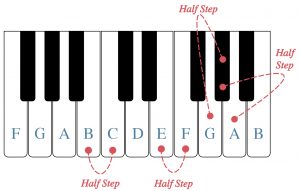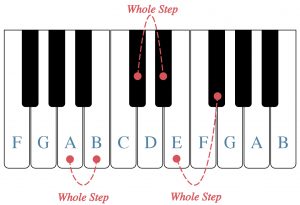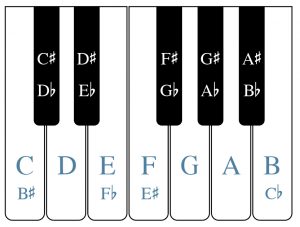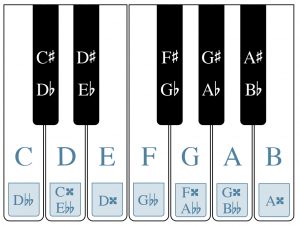Fundamentals
5 Half- and Whole-steps and Accidentals
Chelsey Hamm
Key Takeaways
- A half-step above a key on the piano is the key to its immediate right, while a half-step below a key on the piano is the key to its immediate left.
- A whole-step is two half-steps. A whole-step above a key on the piano is two keys to its right, while a whole-step below a key on the piano is two keys to its left.
- An accidental changes the pitch of a note. A sharp raises a note by a half-step while a flat lowers a note by a half-step. A natural cancels a previous accidental.
- A double sharp raises a note by a whole-step, while a double flat lowers a note by a whole-step.
- Be sure to write accidentals to the left of a note, directly across the line or space on which a note appears.
- Notes have enharmonic equivalence when they are spelled differently but sound the same.
In the last chapter, The Keyboard and the Grand Staff, we discussed the letter names of the white keys on the piano keyboard. There are also black keys on the piano keyboard, which are grouped into alternating sets of two or three. Before we discuss the names of the black keys, however, we must first learn about half- and whole-steps.
Half- and Whole-steps
Example 1 shows a piano keyboard with the letter names of the white key pitches, and some half-steps labeled:

the white keys; some half-steps are labeled.
A half-step is considered to be the smallest interval, or distance between two notes, in western musical notation. On the piano keyboard (see Example 1) a half-step above a white key note (for example, the note G) is the black key to its upper right. Likewise, a half-step below a white key note (for example, the note A) is the black key to its upper left. In other words, the black key to the upper right of G is “in between” the notes G and A. One would say that this black key is a half-step above G and is simultaneously a half-step below A. Two pairs of white keys—E/F and B/C—do not have black keys in between them (see Example 1). This is because E to F is a half-step and B to C is also a half-step. The piano keyboard is arranged like this so that it is easier to play. Having the black keys grouped into sets of either two or three makes seeing and feeling them easier and quicker for a keyboardist.
Example 2 shows a piano keyboard with the letter names of the white key pitches labeled, and some whole-steps bracketed:

A whole-step is the equivalent of two half-steps. Pairs of white keys with a black key in between them (A and B, C and D, D and E, F and G, and G and A) are a whole-step apart. To find a whole-step above the notes E or B, simply count two keys to the right. A whole-step above E is the black key to the right of the note F, while a whole-step above B is the black key to the right of the note C. Likewise, to find a whole-step below the notes C or F, simply count two keys to the left. A whole-step below C is the black key to the left of the note B, while a whole-step below F is the black key to the left of the note E. To find a whole-step from a black key you will want to count two keys to the right or left. For example, a whole-step above the black key to the right of C is the black key to the right of the note D. A whole-step below the black key to the left of B is the black key to the left of the note A.
What do a half-step and a whole-step sound like? The short video, shown in Example 3, demonstrates:
Example 3. Dr. Chelsey Hamm (Christopher Newport University) demonstrates the sound of a half-step and a whole-step.
Sharps, Flats, and Naturals
An accidental changes the pitch of a note. A sharp (♯) looks like a tilted hashtag, and it raises a note by a half-step. A flat (♭) looks like a slanted lowercase “b,” and it lowers a note by a half-step. A natural (♮) looks like a tilted box with a line sticking out of the top left and bottom right corners, and it cancels a previous accidental such as a sharp or flat. Sharps, flats, and naturals are the three most common accidentals.
A double sharp (or ♯♯) raises a note by two half-steps (i.e. a whole-step). A double flat (𝄫) lowers a note by two half-steps (i.e. a whole-step). Accidentals are always written to the left of a note, regardless of stem direction. An accidental should be written directly across the line or space on which a note appears.
Example 4 shows both correct and incorrect ways to notate sharps, flats, and naturals:

The Black Keys on the Piano Keyboard
Example 5 shows a piano keyboard with the letter names of the black keys labeled:

black keys labeled.
Black keys that are a half-step above a white key take the name of the white key and add the word “sharp.” For example, the black key to the right of the note C is called “C-sharp,” and is written as C♯. Black keys that are a half-step below a white key take the name of the white key and add the word “flat.” For example, the black key to the left of the note D is called “D-flat,” and is written as D♭.
F is also known as E♯, and E is also known as F♭. C is also known as B♯, and B is also known as C♭. Double sharp and double flat accidentals also exist, and some of these are found in Example 6. A double sharp is two half-steps above a note. For example, D𝄪 is also E; E𝄪 is also F♯ (or G♭). A double flat is two half-steps below a note. For example, A𝄫 is also G; C𝄫 is also B♭ or A♯.

Enharmonic equivalence
Notice that the keys on the piano keyboard have more than one name. Notes have enharmonic equivalence when they are spelled differently but they sound the same. For example, you can see that C♯ and D♭ are enharmonically equivalent, as seen in Examples 5 and 6. Another example, seen in Example 6, is the note D. This note is enharmonically equivalent with the notes C𝄪 and E𝄫. In other words, playing a D, C𝄪, or E𝄫 will result in the same pitch.
- Tutorial on Half- and Whole-steps (Music Theory Fundamentals)
- Tutorial on Half- and Whole-Steps and Accidentals (musictheory.net)
- Game to Practice Half- and Whole-Steps and Accidentals (drawmusic.com)
- Tutorial on Accidentals (mymusictheory.com)
- Tutorial on the Black Keys on the Piano (musicradar.com)
- Practicing the Piano Keyboard (musictheory.net)
- Matching Game for Piano Key Notes (quizlet.com)
- Labeling Game for Piano Key Notes (quizlet.com)
- Tutorial on Enharmonic Equivalence (The Music Notation Project)
- Typing Game on Enharmonic Equivalence (quizlet.com)
- Matching Game on Enharmonic Equivalence (quizlet.com)
- Half- and Whole-Steps on the Piano Keyboard and in Staff Notation (.pdf)
- Half- and Whole-Steps in Staff Notation (.pdf)
- Writing and Identifying Notes with Accidentals (.pdf, .pdf, .pdf)
- Keyboard to Staff Notation Matching (.pdf)
- Enharmonic Equivalence (.pdf)
- Black Keys on the Piano (.pdf, .docx)
- Half- and Whole-steps on the Piano Keyboard (.pdf, .docx)
- Writing Accidentals (.pdf, .docx)
- Writing and Identifying Accidentals (.pdf, .docx)
- Half- and Whole-steps in Staff Notation (.pdf, .docx)
- Enharmonic Equivalence (.pdf, .docx)
Generally considered to be smallest interval in Western musical notation
Two half-steps
One of many symbols (the sharp (♯), flat (♭), and natural (♮) among others) that alter a pitch
Raises a note by a half-step
Lowers a note by a half-step
Cancels a prior accidental, such as a sharp or flat
Raises a note by two half-steps
Lowers a note by two half-steps
Notes, intervals, or chords that sound the same but are spelled differently
The distance between two notes

